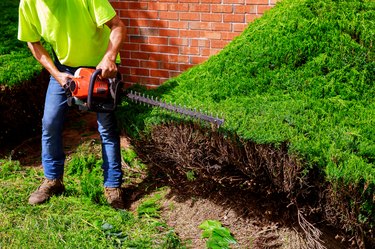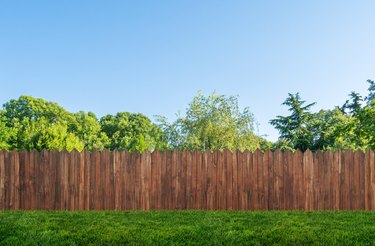Things You'll Need
Hammer, wood stakes, string (optional)
Garden hose
Gloves
Straight-edge shovel

A well-manicured lawn has clean, crisp edges around flowerbeds and along the walkway and driveway. To achieve this detailed look, it's best to use a specific lawn edging tool. While some models are motor-driven, you can buy manual models at a fraction of the cost. Commonly used around existing beds or to create a new bed, a manual edger is similar to a shovel, but the blade is rounded like a half-moon. A manual rotary edger has a roller and a spiked cutting wheel attached to a long handle, and works best along your walkway or driveway.
Half-Moon Edger
Delineate Your Area
Mark the area in your yard where you want to create a new bed and want a crisp edge separating it from the grass. If you're simply freshening up an existing edge, skip to Step 2. To mark a straight edge, hammer a stake at each end, and tie a string between the two to use as an edging guide. If you plan to have curved edges, use a garden hose to indicate the arcs.
Video of the Day
Video of the Day
Position the Edger
Put on work gloves. Grab your lawn edging tool, and stand at one end of the existing or planned edge. Set the rounded edge of the tool on the turf near the existing edge, or in alignment with the guide string or hose if you're creating a new bed. Tilt the handle back about 45 degrees and place your foot on the top, turned edge.
Cut Into the Turf
Push down with your foot and insert the rounded edge into the turf 2 to 3 inches. Rock the edger side to side and up and back to ensure a good cut and loosen the turf. Pull the tool out of the ground; move 4 or 5 inches to your left, and repeat. Continue to the other end of the bed.

Remove the Excess Turf
Return to the start of the edge. Stand on the inside of the bed or the opposite side of the string or hose and repeat the process. Remove the loosened turf with a straight-edge shovel. Add fresh mulch along the edge of an existing bed, or continue planting your new bed.
Rotary Edger
Locate Your Edge
Take a flat-edge shovel and slide it under any grass or vegetation that may be growing over the edge onto your walkway or driveway. This helps you locate the edge and stay on track as you edge.
Position the Lawn Edging Tool
Put on work gloves. Stand at one end of the walkway or driveway. Hold the rotary edger firmly with one hand near the end and the other halfway down the handle. Position and line it up so the wheels are on the walkway or driveway and the cutting spikes are between the turf and the hard surface.
Drive Down the Spikes
Push down to drive the cutting spikes into the ground. With constant downward force, roll the edger forward and backward 10 to 12 inches to cut through the vegetation. You may need to do this several times before you have a clean edge.
Rinse and Repeat

Move forward to the next section, and repeat. Continue along the edge of the walkway or driveway until you get to the end. Remove the vegetation with your shovel. Hose down the hard surface to wash off any clippings or dirt.
Tip
The edging process is easier if you dampen the ground beforehand.
Warning
Manual edging can be hard on your back. To help avoid back discomfort, wear a back support.